That's from Mark Wiseman's list of "Picture Subjects Most Interesting to Women" and based on 20 years of accumulated data culled from readership reports.
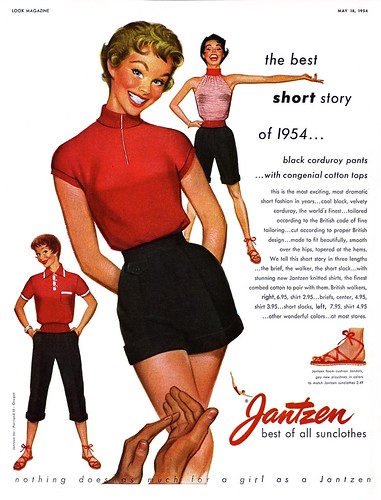
"The reason is not that each sex is not interested in pictures of the other," explains Wiseman, "but that the sex of the sole or dominant figure in a picture is a symbolic selector: a signal to the reader that the advertisement is directed to one sex or the other."
Some other picture subjects most interesting to (1950's) women: "children, babies, domestic situations, apparel and interior scenes..."
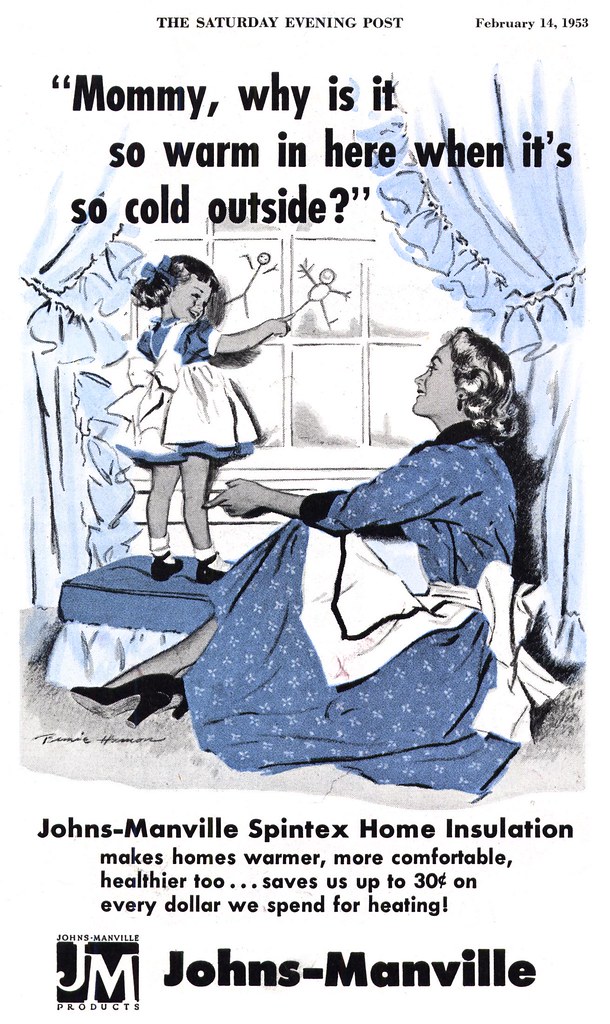
"...flowers..."

"... jewelry and other personal accessories..."
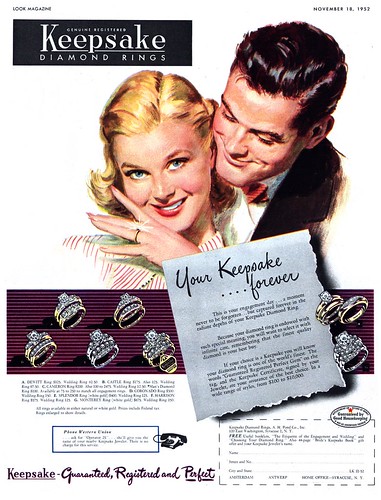
"... realistic foods..."
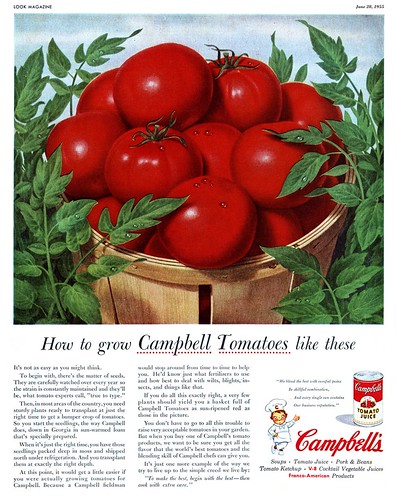
"Don't use sports scenes unless the chief figure is a woman," advises Wiseman.
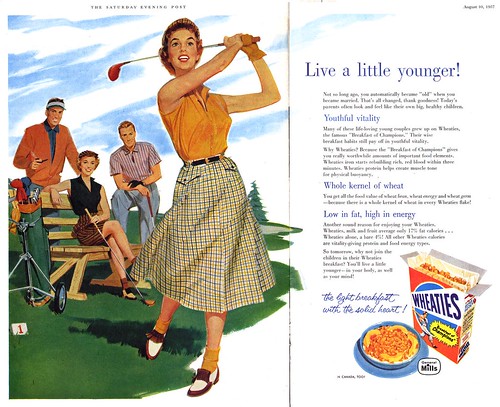
"The automobile is strictly a man-symbol," says Wiseman, "and usually induces few women to look."
So how to attract female viewers to a spread of nothing but cars? "Say it with flowers!"
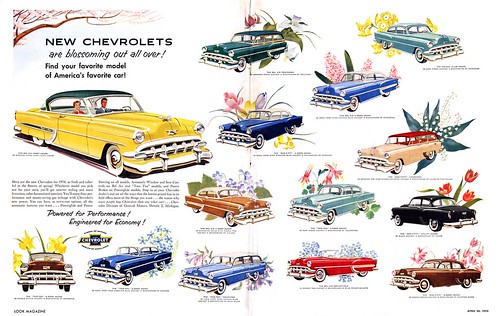
"Women love flowers and decorative accessories."
From "Reader Research and the Art Director's Job" in the March 1952 issues of Art Director and Studio News.
The only reason I can think of that a woman would be attracted to this automobile ad adorned with flowers --because it is so bizarre, I have to look at it more closely!
ReplyDeleteWow, I love those huge almond eyes in the Jantzen ad. Very Peter Pan/Tinkerbell. There was an artist who did those distinctive eyes back then. Name escapes me.
ReplyDeleteLeif, you just had to slip in one more picture of a cute tomato, didn't you?
ReplyDeleteAnd by the way, Leif, is there a flickr set for the last dozen illustrations. I'd love to see the huge versions.
ReplyDeleteAs always, thanks very much for all this good stuff and info Leif.
Les Toil, I think the guy that painted the children with the big eyes in the 50's, was Walter Keane (sp?) and his wife also did similar paintings. Kinda bizarre... they looked like trolls.
ReplyDeleteSo far, I think Mark Wiseman got it right, and most of the men and women I talk to today, look at ads that they can relate to. I think women, for the most part, are still into fashions and they like to go shopping. I don't think men like to shop unless it is something they specifically want, like electronics, hardware, cars, trucks, guns, etc. I hear woman complain that their husbands usually refuse to go shopping with them. Yeah, I know, there are always exceptions to the rule... my wife really likes model trains!
Tom Watson
Thanks all, for your comments!
ReplyDeleteRuth; the car ad may seem bizarre by today's standards - but it actually makes good use of Wiseman's theories of attracting the audience you're trying to reach. the example he used in his article I couldn't locate... but it was a spread showing a Cadillac with an elaborate necklace hugely superimposed in the background.
"The average woman-noting for 4 other 4-color automobile ads in the same issue, besides cadillac, was 29% compared with 54% of men. But Cadillac attracted 57% women with the addition of the necklace."
Interesting, huh?
Les; the artist of the top image is
Pete Hawley and yes, he did do those distinctive pixie-ish eyes, both on his women and his men. This piece is from near the end of his long run of Jantzen ads.
david - ha!
Les again; I haven't yet organized all of these ads into their appropriate sets... best just to surf the tail end of my Flickr photostrem and you'll find everything there in chronological order.
Tom; I agree with you that not much has changed when it comes to using images to attract certain audiences. In spite of the supposed sophistication of the consumer today, we generally are still attracted to the things we found interesting when we were little boys and girls. And as big boys we still have as little time for 'girl stuff' as we did when we were busy building go-carts or shootin' injuns. ;-)
Thanks, Leif. It's always interesting to see the thinking behind the artwork.
ReplyDeleteI took an advertising seminar in the late 70s, and the presenter gave essentially the same summary of what men and women look at in ads. The information was apparently based on scientific studies. I don't know whether advertisers still regard this approach as valid.
I think consumer trends have changed as well. Car ads are directed to women a lot of the time because women now have purchasing power. And if you look at a website like apartmenttherapy.com you will see that as many men as women are obsessed with interior design and furniture design.
ReplyDeleteThose surveys are only as accurate as the demographics they chose to pay attention to.
liza;
ReplyDeleteThat may be true of certain modern (urban) demographics... but I'll bet that if you had a really broad spectrum study - a truly nationwide sample that includes all those salt o' the earth types in small towns across the farm and bible belts - you'd see an almost identical list to this 1950's one.
The interesting thing to keep in mind about the source of Wiseman's data is what a different place America was back then in terms of media consumption and community participation.
Most people got their information from newspapers and magazines (magazines like the Saturday Evening Post and Ladies Home Journal had circulation numbers that would make any contemporary publisher weep with envy) - and the readers wrote in in droves. They let the publishers know how they felt about the contents - and the publishers listened. During that 20 year stretch that Wiseman culled his survey info from, America was still a nation of small towns - and small town traditional thinking.
That's the same demographic that, 50 years later, elected GW Bush! ;-)
*incidentally, a lot of car ads back then were also directed at women... but often in a subtler way that reflected the nature of how many families handled their finances. Women had buying power then, too... the husband earned the money, but the wife controlled the money. Subsequently, you see a lot of auto ads like this one, where an enthusiastic husband is looking to his spouse for permission.
If you read the underlying message in these ads, you quickly come to realize who is *really* buying the car!
Hi Lief,
ReplyDeletehappy new year..all the advertising art reminds me, have you been listening to " The Age of Persuasion" on CBC radio, with Terry O' Reilly? Very astute look at role of advertising back then and now. Must-Listen stuff!
PS - Re: Art Fitzpatrick: Visited him once with Ken Steacy...great guy! How did he fare during the recent fires?
Scott; that sounds like a very cool show - I'll try to check it out.
ReplyDeleteNi idea how Fitz did during the fires... I have no way to contact him, unfortunately...
"Les; the artist of the top image is
ReplyDeletePete Hawley and yes, he did do those distinctive pixie-ish eyes, both on his women and his men."
Bingo!! That's him alright, Leif! I love Hawley's almond eyes!
"Les Toil, I think the guy that painted the children with the big eyes in the 50's, was Walter Keane (sp?) and his wife also did similar paintings."
Thanks for the help Tom, but I said almond eyes, not eyes the size of tea cups. LOL :) :)
And by the way Tom, it was revealed quite a while back that it was actually his wife that painted ALL of the work Walter Keane signed and claimed his own. Walter Keane was much more of an out-going business type person than his wife was so they made an agreement that she would create the art and he would be the amiable huckster charming the public with these wide-eyed creations in their San Francisco gallery. When he later disputed that she did all the art, they had a public paint-off and the poor shmuck could barely paint a stick figure.
My mother, who remembers going to their galley in S.F. in the 1960s and meeting Walter, told me recently those big-eyed children were just as hideous then as they are now. :)
Everyone's an art critic.